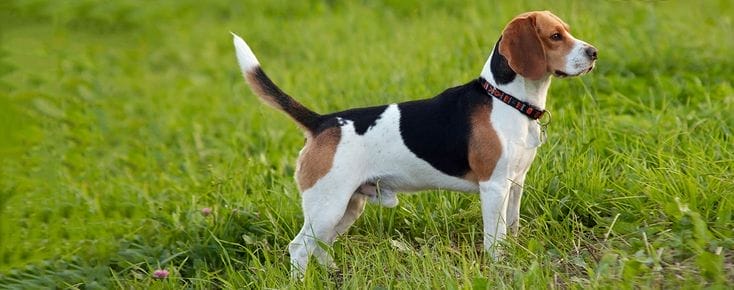Foxhounds have been selectively bred for their hunting ability and persistence since the 16th century. They work together in packs to follow a fox’s trail over long distances by scent. Their speed, athleticism and vocal nature aid the hunt. Continue to be used for this traditional sport today.
Introduction Foxhound Dog Breed
The Foxhound is a medium-large hunting dog renowned for its keen sense of smell, athleticism and endurance. They were developed in Britain centuries ago specifically for the sport of fox hunting. Their remarkable ability to pick up and follow a scent through all kinds of terrain led to their proliferation across Britain and later North America.
Foxhounds are driven, energetic dogs that are happiest when on the move and hot on a trail. They form close bonds with their human and canine packmates. Outside of hunting contexts, they make lively family companions but do require plenty of daily activity. Pack dogs at heart and don’t do well isolated for long periods.

Adaptability: ⭐⭐
Apartment Living: ⭐
Novice Owners: ⭐⭐
Sensitivity: ⭐⭐⭐
Alone Time: ⭐
Cold Weather: ⭐⭐⭐
Hot Weather: ⭐⭐
All Around Friendliness: ⭐⭐⭐
Family Affection: ⭐⭐⭐⭐
Kid Friendly: ⭐⭐⭐
Dog Friendly: ⭐⭐⭐⭐
Stranger Friendly: ⭐⭐
Grooming Needs: ⭐⭐
Shedding: ⭐⭐
Drooling: ⭐
Ease of Grooming: ⭐⭐⭐
General Health: ⭐⭐⭐
Weight Gain: ⭐
Size: ⭐⭐⭐
Trainability: ⭐⭐⭐
Ease of Training: ⭐⭐
Intelligence: ⭐⭐⭐
Mouthiness: ⭐⭐⭐
Prey Drive: ⭐⭐⭐⭐⭐
Barking Tendency: ⭐⭐⭐⭐
Wanderlust: ⭐⭐⭐⭐⭐
Exercise Needs: ⭐⭐⭐⭐⭐
Energy Level: ⭐⭐⭐⭐⭐
Intensity: ⭐⭐⭐⭐
Exercise Needs: ⭐⭐⭐⭐
Playfulness: ⭐⭐⭐
- Appearance: Athletic build, long muzzle, hanging ears. Coarse coat in tricolor (black/white/tan) or just white.
- Characteristics: Driven hunters with excellent stamina. Use keen sense of smell to track prey. Fast runners and energetic dogs.
- Popularity: Ranked 109th most popular breed by AKC. More common in Europe than North America nowadays.
- Lifespan: 10-13 years on average.
- Temperament: Energetic, determined, and pack-oriented. Devoted and loyal. Love being on the move.
- Coat Colors: Tricolor (black, white and tan) or just white. May have ticking or spots.
- Origins: Developed in Britain to hunt foxes. Includes multiple strains like English, American, Welsh, and Trigg foxhounds.
Foxhound Care Recommendations
Foxhounds have high activity needs and do best with an active family. Here are some tips for keeping them happy and healthy:
Food:
- High-protein commercial dog food. 3-4 cups for a 50 lb dog.
- Meat should be first ingredient. Avoid fillers.
- Supplement with joint aids and glucosamine.
Environment:
- Safely fenced yard to run and play in. Foxhounds roam if able.
- Lots of daily exercise – long walks, running, hiking.
- Mentally stimulating toys and chews. Avoid boredom.
Grooming:
- Weekly brushing of short, hard coat. Bathe only when needed.
- Check and clean ears regularly. Long, floppy ears prone to infection.
- Trim nails every 2-3 weeks. Inspect feet post-exercise.

Enrichment:
Scent games, obedience training, agility, and vigorous interactive play.
Preparing for a Foxhound Dog Breed
Here are some tips to get ready before bringing one of these energetic hounds home:
- Fox-proof your yard. They will roam and follow scents if able. Ensure secure fencing.
- Prepare for plenty of exercise. Need 1+ hours daily. Walks, running, fetch, etc.
- Buy puzzle toys and chews. They need mental stimulation too.
- Invest in good vacuum if adopting an adult. Shed moderately.
- Stock up on quality dog food and treats made for active breeds.
- Essentials: leash, collar, ID tag, bed, bowls, brush, nail clippers, toys.
- Health issues: ear infections, bloat, joint dysplasia. Lifetime vet costs can be high.
- Vaccines: Core vaccines, rabies, leptospirosis, Lyme disease, kennel cough.
Popular Foxhound Dog Names
Give your foxhound a name that nods to their heritage:
- English origin names like Winston, Henry, Lily, Margaret.
- Hunting related names like Chaser, Hunter, Arrow.
- Mythological fox names like Reynard, Tod, Vixen.
- Foxhound pack names like relay, chase, hunt.
How to buy/adopt a Foxhound
- Most common in Europe, especially Britain. Some breeders in North America.
- Adoption fee typically $100-$300. Show quality dogs cost more.
- Check breed clubs and rescues like Foxhound Rescue of America.
- Ensure puppy or adult dog has friendly, stable temperament.
- Look for signs of good health – clear eyes/coat, no odor, lively.
- Reputable breeders screen for hip dysplasia, eye issues, and more.

How can I stop my foxhound from biting?
Redirect biting onto chew toys and bones. Ensure they get plenty of exercise. Firmly tell them “no” if biting.
How do I socialize and train a friendly foxhound?
Start young with extensive positive socialization. Use reward-based training and be patient – they can be stubborn.
How do I train?
Use positive reinforcement, consistency, and patience. Food motivation helps. Avoid harsh corrections. Socialize them thoroughly.
How often should I take a foxhound to the vet?
Annually for core vaccines and checkup. Senior dogs may need biannual visits. Follow up if any health concerns arise.
Are foxhounds good family pets?
Yes, when provided enough exercise and training. Their affectionate nature suits family life. Supervise with very young kids.
Are dogs good with kids?
Yes, raised with children they get along very well. Always supervise young kids and teach them gentle handling.
Are foxhounds good with other dogs?
They tend to get along very well with other dogs due to their pack mentality. Best housed with another canine companion.
Are foxhounds intelligent dogs?
Yes, they are bright and trainable, but can be independent thinkers. Positive reinforcement works best.
What is the foxhound temperament like?
Energetic, determined, friendly, and pack-oriented. They form close bonds and love being active with their families.
How many types of foxhounds are there?
Many strains were developed for specific regions or prey, including English, American, Welsh, Trigg.
What colors do foxhounds come in?
The most common colors are tricolor (black, white and tan spots), solid white, or a combination of white with black and/or tan spots.
How long do foxhounds live?
The average life expectancy is 10-13 years with proper care, exercise, and veterinary attention.
Can foxhounds cause allergies?
Shed moderately year-round. Their short coats produce less dander than some breeds, but allergies are still possible. Regular brushing and bathing helps reduce loose hair and dander.
Are foxhounds aggressive or dangerous?
Generally quite friendly and enthusiastic dogs. They can be rambunctious when young, but are not typically aggressive when properly socialized and trained. Supervise fully around small children and other pets.
Do foxhounds have problems with hair loss or shedding?
Shed moderately year-round. They blow their coats once or twice per year, which leads to more shedding during those periods. Overall their grooming needs are relatively low maintenance compared to other breeds. Regular brushing helps keep shedding under control. Hair loss is not a major issue.
By following our website, you can find the perfect dog breeds for you and provide them with the best possible dog care. Remember that owning a dog is a lifelong commitment that requires time, money, and patience. But it is also a rewarding experience that will bring you joy and companionship. All information in Dog care tips.

